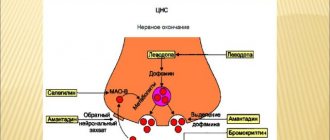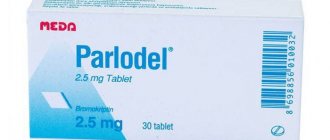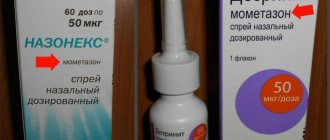Dosage
Set individually depending on the severity of shock, blood pressure and the patient’s response to dopamine administration. In order to increase myocardial contractility and increase diuresis, 100-250 mcg/min is administered intravenously. If it is necessary to influence blood pressure, the dose is increased to 300-500-700 mcg/min.
Children are administered at a dose of 4-6 mcg/kg/min.
The duration of dopamine use can be up to 28 days.
The maximum dose for adults with intravenous drip administration is 1.5 mg/min.
Use of the drug Dopamine
Administered intravenously. 25 or 200 mg are diluted, respectively, in 125 or 400 ml of 5% glucose solution or isotonic sodium chloride solution so that 1 ml of solution contains 200 and 500 mcg of dopamine, respectively. If there are contraindications to the administration of large volumes of liquid, more concentrated solutions are used, diluting 200 mg in 250 ml of the above solutions (1 ml contains 800 mcg of dopamine). The initial rate of administration for an average body weight of 70 kg is 1–4 mcg/kg per 1 min (2–11 drops of 0.05% solution or 1.5–6 drops of 0.08% solution). The therapeutic dose is 5–9 mcg/kg per 1 minute. For vasodilation and arterial hypotension, it is advisable to use dopamine at a dose of 10–15 mcg/kg per minute. If necessary, the rate of administration is increased to 18 mcg/kg per minute. The infusion is carried out continuously for from 2–3 hours to 1–4 days or more. The daily dose reaches 400–800 mg. The administration is carried out under ECG control. The dose and rate of administration are determined taking into account the level of blood pressure, heart rate, heart rate, cardiac output and diuresis. A decrease in diuresis without arterial hypotension indicates the need to reduce the dose.
Side effects
From the cardiovascular system: tachycardia or bradycardia, chest pain, increased or decreased blood pressure, conduction disturbances, widening of the QRS complex, vasospasm, increased end-diastolic pressure in the left ventricle; when used in high doses - ventricular or supraventricular arrhythmias.
From the digestive system: nausea, vomiting, bleeding from the gastrointestinal tract.
From the nervous system: headache, anxiety, motor restlessness, tremor of the fingers.
Metabolism: polyuria.
Allergic reactions: in patients with bronchial asthma - bronchospasm, shock.
Local reactions: when dopamine gets under the skin - necrosis of the skin and subcutaneous tissue.
Other: shortness of breath, azotemia, piloerection, when administered in low doses - polyuria.
Pharmacological properties of the drug Dopamine
Catecholamine, neurotransmitter. Endogenous dopamine is a metabolic precursor to norepinephrine (norepinephrine) and epinephrine (adrenaline). It has a specific stimulating effect on dopamine receptors, and in high doses also stimulates α- and β-adrenergic receptors. Under the influence of dopamine, peripheral vascular resistance and systolic blood pressure levels increase, heart contractions increase, and cardiac output increases. Heart rate changes slightly; the myocardial oxygen demand increases, but due to the increase in coronary blood flow, more significant oxygen delivery is provided. The use of dopamine increases blood flow in the vessels of the heart, brain, intestines and kidneys, as well as glomerular filtration and sodium excretion by the kidneys. The effect of dopamine occurs quickly and ends 5–10 minutes after the end of the IV infusion. The half-life is about 2 minutes. Approximately 50% of dopamine is bound to plasma proteins. Dopamine is rapidly metabolized in the liver, kidneys and blood plasma under the action of MAO and catechol-O-methyltransferase to inactive metabolites and is intensively excreted by the kidneys. About 25% of the administered dose is metabolized to norepinephrine at the adrenergic nerve endings. Due to rapid elimination, dopamine does not accumulate in the body even with long-term infusions.
Drug interactions
When used simultaneously with diuretics, the diuretic effect of dopamine is enhanced.
With the simultaneous use of MAO inhibitors (including furazolidone, procarbazine, selegiline), guanethidine, the intensity and duration of the cardiac stimulating and pressor effects of dopamine may be increased.
The administration of dopamine while taking tricyclic antidepressants (including maprotiline) leads to an increase in its effects (possible development of tachycardia, arrhythmia, severe arterial hypertension).
When used simultaneously with octadine, the sympathomimetic effect is enhanced.
There is a report of the development of severe arterial hypotension with simultaneous use of dopamine with phenytoin.
When used simultaneously with inhalation agents for general anesthesia, hydrocarbon derivatives (including cyclopropane, chloroform, enflurane, halothane, isoflurane, methoxyflurane), the risk of developing severe heart rhythm disturbances increases.
Other sympathomimetics, as well as cocaine, enhance the cardiotoxic effect.
Butyrophenone derivatives and beta-blockers reduce the effect of dopamine.
Dopamine reduces the hypotensive effect of guanadrel, guanethidine, methyldopa, and rauwolfia alkaloids (the latter prolong the effect of dopamine).
When used simultaneously with levodopa, there is an increased risk of arrhythmias.
When used simultaneously with thyroid hormones, it is possible to enhance the effect of both dopamine and thyroid hormones.
Ergometrine, ergotamine, methylergometrine, oxytocin increase the vasoconstrictor effect and the risk of ischemia and gangrene, as well as severe arterial hypertension, including intracranial hemorrhage.
When used simultaneously with cardiac glycosides, there may be an increased risk of heart rhythm disturbances and an additive positive inotropic effect.
Reduces the antianginal effect of nitrates, which in turn can reduce the pressor effect of sympathomimetics and increase the risk of arterial hypotension.
Pharmaceutically incompatible with alkaline solutions (inactivate dopamine), oxidizing agents, iron salts, thiamine (promotes the destruction of vitamin B1).
Pharmacodynamics and pharmacokinetics
Dopamine - what is it? According to Wikipedia, dopamine is one of the most important neurotransmitters produced in the brains of humans and animals. The substance is a precursor to adrenaline and norepinephrine . Plays an important role in the processes of human motivation and learning.
Dopamine is a diuretic and cardiotonic . The drug also tends to increase blood pressure . The active substance acts on dopamine receptors and dilates blood vessels. The degree of resistance of the renal vascular endothelium decreases, glomerular filtration and the process of diuresis , sodium ions are more efficiently removed from the body.
The drug in small and moderate doses stimulates beta-1 adrenergic receptors and increases minute blood . During use of the drug, systolic blood pressure , myocardial oxygen demand, and blood flow in the coronary vessels .
Due to the use of a large amount of the drug, the heart rate , the vessels of the kidneys narrow, and the pressure during systole and diastole increases.
After introducing the medicine into the body, the drug reaches its maximum effect after 5 minutes. After 10 minutes, the effect of the product is significantly reduced.
special instructions
Use with caution in case of hypovolemia, myocardial infarction, cardiac arrhythmias (tachyarrhythmias, ventricular arrhythmias, atrial fibrillation), metabolic acidosis, hypercapnia, hypoxia, hypertension in the pulmonary circulation, thyrotoxicosis, angle-closure glaucoma, prostatic hyperplasia, occlusive vascular diseases (in including atherosclerosis, thromboembolism, thromboangiitis obliterans, endarteritis obliterans, diabetic endarteritis, Raynaud's disease, frostbite), with diabetes, bronchial asthma (if there was a history of increased sensitivity to disulfite), pregnancy, lactation, in children and adolescents aged up to 18 years old.
If hypovolemia is present, it should be compensated before dopamine administration.
Dopamine should be administered under the control of heart rate, blood pressure, ECG, and diuresis; It is also recommended to monitor cardiac stroke volume, ventricular filling pressure, central venous pressure, and pulmonary artery pressure. A decrease in diuresis indicates the need to reduce the dose.
When using MAO inhibitors, the dose of dopamine should be reduced by 10 times.
Dopamine
Special conditions
The drug Dopamine Admeda is intended only for intravenous infusion and can only be used in diluted form! In patients in shock, hypovolemia should be corrected by administering plasma and other blood substitute fluids before administering the drug. The infusion rate should be constantly adjusted based on the patient's condition. The infusion should be carried out under the control of diuresis, heart rate, minute blood volume, blood pressure, ECG. A decrease in diuresis without a concomitant decrease in blood pressure indicates the need to reduce the dose of Dopamine Admeda. Since Dopamine Admeda improves atrioventricular conduction, patients with atrial fibrillation and rapid ventricular response should be given cardiac glycosides before administering Dopamine Admeda. With long-term parenteral nutrition and in all cases (according to indications), the volume of circulating blood, water and electrolyte balance, acid-base status, and the state of liver and kidney function should be regularly assessed. MAO inhibitors, increasing the pressor effect of sympathomimetics, can cause headache, arrhythmia, vomiting and other manifestations of hypertensive crisis, therefore, in patients who have received MAO inhibitors over the past 2-3 weeks, the initial doses of Dopamine Admed should be no more than 10% of the usual doses. Strictly controlled studies of the use of the drug in patients under the age of 18 have not been conducted (there are isolated reports of the occurrence of arrhythmias and gangrene in this group of patients associated with extravasation of the drug during intravenous administration). To reduce the risk of extravasation, it is recommended to inject the drug into large veins. To prevent tissue necrosis in case of extravasal ingestion of the drug, infiltrate with 10-15 ml of 0.9% sodium chloride solution with 5-10 mg of phentolamine. Considering the pharmacological properties of the drug, special attention should be paid to the inadmissibility of intravenous infusions and bolus injections! Patients in a coma need to ensure airway patency. Prescribing the drug against the background of occlusive diseases of peripheral vessels and/or a history of disseminated intravascular coagulation can cause a sharp and pronounced vasoconstriction, leading to skin necrosis and gangrene (careful monitoring should be carried out, and if signs of peripheral ischemia are detected, the drug should be stopped immediately).
Indications for use
Dopamine is prescribed:
- for various types of shock (traumatic, cardiogenic, infectious-toxic, anaphylactic, after surgery );
- after poisoning, if it is necessary to force diuresis ;
- in case of hypovolemic shock , after the volume of circulating blood is restored;
- for relief of acute cardiovascular failure ;
- with a decrease in blood pressure .
Overdose
In case of an overdose of the synthetic hormone dopamine, the following are observed: cyanosis , nausea , vomiting , increased blood pressure , tachycardia , spasm of arteries in the periphery, arrhythmia , angina pectoris , pain in the chest, the appearance of extrasystoles .
If the above symptoms appear, you should immediately stop the infusion , possibly using Nitroglycerin or beta-blockers .
Side effects
May occur:
- tachycardia , chest pain, bradycardia blood pressure surges , vasospasm , arrhythmia ( ventricular or supraventricular );
- necrosis of the skin or subcutaneous tissue when the drug gets under the skin;
- headaches , tremors , anxiety;
- shock , bronchospasm ;
- nausea, bleeding in the gastrointestinal tract, vomiting;
- polyuria;
- shortness of breath , goose bumps , azotemia .
Contraindications
The medicine is not prescribed for:
- pheochromocytoma;
- allergies to its components;
- hypertrophic obstructive cardiomyopathy;
- ventricular fibrillation.
Particular care should be taken:
- with myocardial infarction and heart rhythm disturbances;
- patients with diabetes mellitus or atherosclerosis ;
- hypovolemia;
- with thromboangiitis obliterans ;
- patients with metabolic acidosis ;
- for angle-closure glaucoma ;
- persons suffering from hypertension ;
- with hypercapnia ;
- atherosclerosis;
- during breastfeeding ;
- with thyrotoxicosis ;
- thromboembolism;
- patients with prostatic hyperplasia ;
- pregnant women;
- for frostbite and Raynaud's disease ;
- for bronchial asthma .




